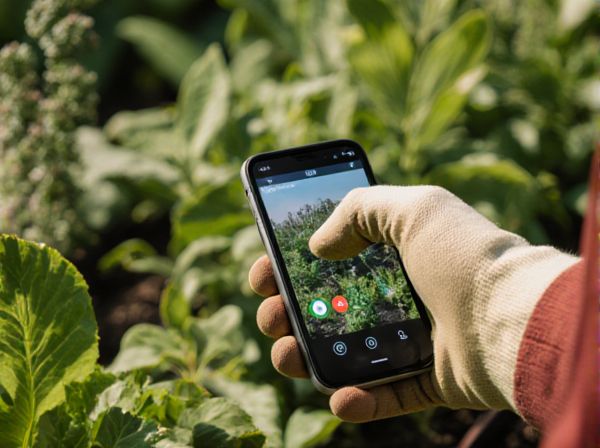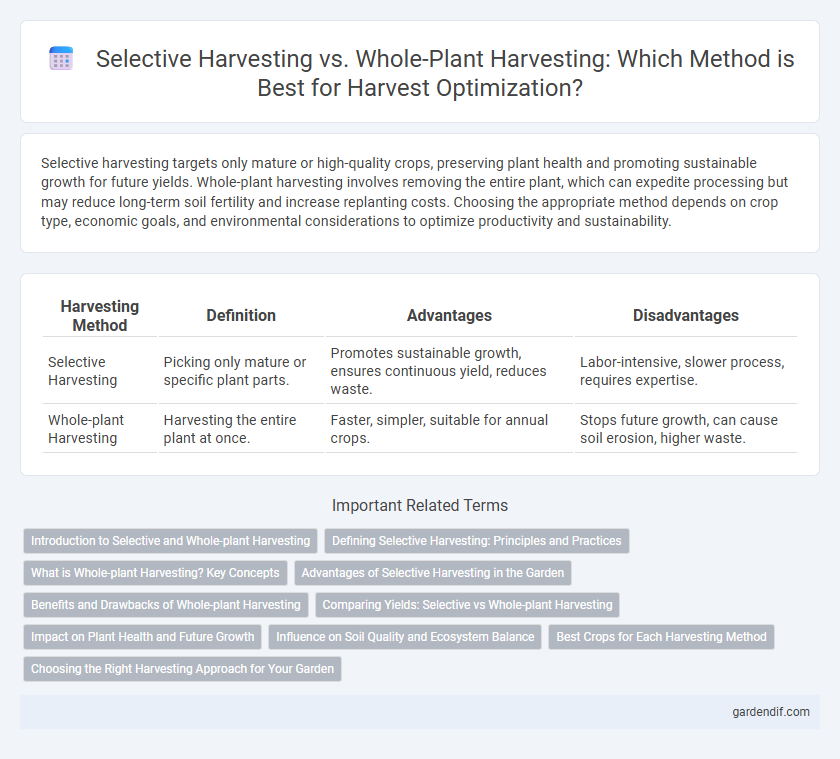
Selective Harvesting vs Whole-plant Harvesting Illustration
Selective harvesting targets only mature or high-quality crops, preserving plant health and promoting sustainable growth for future yields. Whole-plant harvesting involves removing the entire plant, which can expedite processing but may reduce long-term soil fertility and increase replanting costs. Choosing the appropriate method depends on crop type, economic goals, and environmental considerations to optimize productivity and sustainability.
Table of Comparison
| Harvesting Method | Definition | Advantages | Disadvantages |
|---|---|---|---|
| Selective Harvesting | Picking only mature or specific plant parts. | Promotes sustainable growth, ensures continuous yield, reduces waste. | Labor-intensive, slower process, requires expertise. |
| Whole-plant Harvesting | Harvesting the entire plant at once. | Faster, simpler, suitable for annual crops. | Stops future growth, can cause soil erosion, higher waste. |
Introduction to Selective and Whole-plant Harvesting
Selective harvesting targets only mature or high-quality crops, enhancing sustainability by allowing continuous growth and reducing waste. Whole-plant harvesting involves collecting the entire plant at once, maximizing immediate yield but often leading to soil depletion and habitat disturbance. Understanding these methods helps optimize agricultural productivity while balancing environmental impacts.
Defining Selective Harvesting: Principles and Practices
Selective harvesting involves carefully choosing specific plants or plant parts based on maturity, quality, or health to optimize yield and sustainability, minimizing environmental impact. This method prioritizes maintaining the overall plant population by leaving immature or less desirable specimens to continue growing, which supports biodiversity and long-term productivity. Practices include monitoring growth cycles, assessing plant conditions, and applying precise cutting techniques to ensure regeneration and resource conservation.
What is Whole-plant Harvesting? Key Concepts
Whole-plant harvesting involves collecting the entire crop at once, including stems, leaves, flowers, and roots, maximizing total biomass yield. This method simplifies harvesting operations but can reduce selective quality control and may increase the risk of including immature or damaged plant parts. Whole-plant harvesting is commonly used in forage production and biomass energy crops where quantity outweighs individual component quality.
Advantages of Selective Harvesting in the Garden
Selective harvesting in the garden enhances plant health by allowing mature fruits or vegetables to be picked while leaving younger ones to grow, leading to prolonged productivity and higher overall yield. This method minimizes plant stress and reduces the risk of disease spread compared to whole-plant harvesting, which removes the entire plant and often disrupts soil structure. Gardeners benefit from selective harvesting through better resource use, improved crop quality, and continuous production cycles.
Benefits and Drawbacks of Whole-plant Harvesting
Whole-plant harvesting maximizes biomass yield by collecting the entire crop, which is ideal for producing bulk raw materials and bioenergy. However, this method can lead to soil nutrient depletion and reduced regrowth potential, impacting long-term sustainability. It also limits selective quality control, as all plant parts, including less desirable ones, are harvested together.
Comparing Yields: Selective vs Whole-plant Harvesting
Selective harvesting optimizes yields by targeting mature, high-quality crops while preserving plant health for future growth cycles, resulting in sustained productivity. Whole-plant harvesting maximizes immediate yield volume but can reduce subsequent harvest potential due to complete plant removal. Studies show selective harvesting can increase long-term yield efficiency by up to 25%, whereas whole-plant harvesting often leads to soil nutrient depletion and lower regenerative capacity.
Impact on Plant Health and Future Growth
Selective harvesting preserves the main structure of the plant by removing only mature or damaged parts, promoting healthier regrowth and sustained productivity. Whole-plant harvesting often stresses the plant, leading to slower recovery and potentially reduced yields in subsequent growth cycles. Maintaining selective harvesting practices supports long-term plant vitality and resilience against environmental stresses.
Influence on Soil Quality and Ecosystem Balance
Selective harvesting preserves soil quality by minimizing disturbance to root systems and organic matter, promoting nutrient cycling and microbial biodiversity essential for ecosystem resilience. Whole-plant harvesting often depletes soil nutrients rapidly due to the removal of entire biomass, leading to increased soil erosion and reduced habitat complexity for soil organisms. Maintaining ecosystem balance favors selective methods, which support long-term soil fertility and sustain diverse plant and animal communities.
Best Crops for Each Harvesting Method
Selective harvesting suits perennials and fruit crops like grapes, apples, and coffee, enabling multiple yields over time and preserving plant health. Whole-plant harvesting is ideal for annuals and root vegetables such as wheat, corn, carrots, and potatoes, where the entire plant is removed at maturity. Each method optimizes yield quality and resource efficiency according to crop lifecycle and production goals.
Choosing the Right Harvesting Approach for Your Garden
Selective harvesting allows for the gradual collection of mature fruits or vegetables, promoting continuous growth and extended yield throughout the season. Whole-plant harvesting involves cutting the entire plant at once, ideal for crops that mature uniformly or when aiming for a complete seasonal harvest. Choosing the right harvesting approach depends on crop type, growth patterns, and personal garden goals to maximize productivity and quality.
Selective Harvesting vs Whole-plant Harvesting Infographic

 gardendif.com
gardendif.com